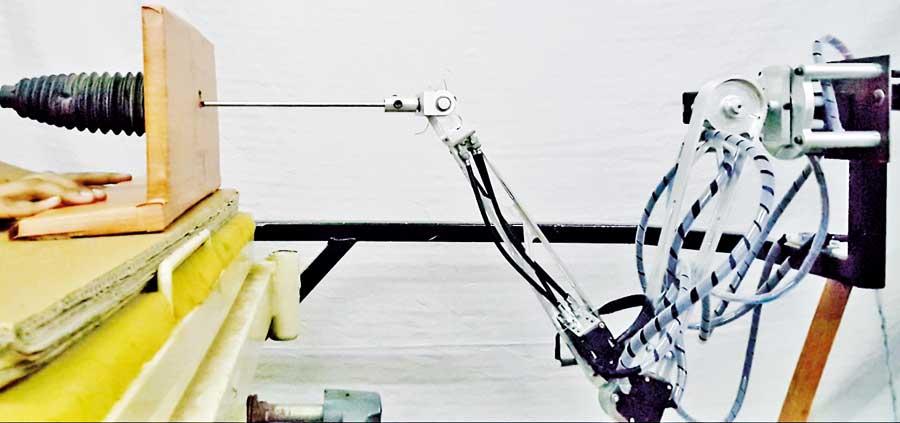10 Mar 2021 - {{hitsCtrl.values.hits}}

A hand-controlled novel assistive Robotic Manipulator for Gynaecological Laparoscopy has been developed by four final year students from the Department of Mechanical Engineering, University of Moratuwa.
four final year students from the Department of Mechanical Engineering, University of Moratuwa.
Before the clinical trial, the team is expected to confirm capabilities of the robot using a corpse.
Four undergraduates, H.A.G.C.Premachandra, K.M.Thathsarana, H.M.A.N.Herath, and D.L.F.M. Liyanage did the research with help, advise and guidance coming throughout the development process by Dr.Ranjith Amarasinghe, Director of Center for Advanced Mechatronics Systems and Senior Lecturer of Department of Mechanical Engineering, University of Moratuwa, Dr. Madura Jayawardane, Consultant Obstetrician and Gynaecologist and Senior Lecturer of Faculty of Medical Sciences, the  University of Sri Jayawardanepura and Dr.Kanishka Madusanka, Lecturer of Department of Mechanical Engineering, University of Moratuwa.
University of Sri Jayawardanepura and Dr.Kanishka Madusanka, Lecturer of Department of Mechanical Engineering, University of Moratuwa.
The concept behind this assistive robot came after a thorough discussions with Consultant Dr. Madura Jayawardane whose continuous supports and advice helped the team to complete the project successfully.
The Laparoscopic surgeries are also known as minimally invasive surgeries, used for gynecological procedures such as laparoscopic hysterectomy and myomectomy.
Reference to the Robotic Manipulator, Dr. Ranjith Amarasinghe commented, ‘’In the traditional hysterectomy Laparoscopic surgery, the main surgeon and two additional doctors are involved. The assistant doctors are carrying out the tasks under the verbal guidance of the main surgeon. The first assistant doctor holds the laparoscope whereas the second assistant doctor performs uterine manipulation using a uterine manipulator (surgical tool) to optimally place the uterus within the pelvis for a safe and efficient surgical procedure. When the verbal commands are given by the main surgeon is inconvenient and tiring, it might cause miscommunication which results in an inefficient surgical procedure. The assistant doctor’s hand is also subjected to fatigue and therefore causes tremors when holding the uterine in fixed positions for a long time. The developed robotic manipulator can replace the second assistant doctor who performs the uterine positioning task while giving complete control of uterine manipulation to the main surgeon.
This Robotic Manipulator is controlled by hand gestures of the main surgeon through the motion controller interface. The user-friendly touch-less interaction with the robot makes it suitable for the surgical environment as opposed to touch screens and joysticks which require frequent sterilization of the contact surfaces. The Robotic Manipulator utilises a reusable uterine manipulator (uterine sound) thus, providing a low-cost solution compared to commercially available uterine manipulators. It performs 4 basic motions required for uterine manipulation; anteversion and retroversion, lateral movement, tensioning and twisting which are controlled by 4 distinct hand gestures of the main surgeon. This robotic assistant is capable of keeping the uterus in a fixed position for extended periods without causing any fatigue. The movements of the robot have been validated on a medical manikin and the team is expected to carry out further trials on a corpse before proceeding to clinical trials.’’
The students would like to express their gratitude to Prof Kapila Perera, former Vice-Chancellor, University of Moratuwa, Prof. Nalin Wickramarachchi, Dean, Faculty of Engineering, Prof. Ruwan Gopura, former head, Department of Mechanical Engineering, the non-academic staff of mechanical workshops, and everyone who extended support to successfully carry out the project.
27 Nov 2024 21 minute ago
27 Nov 2024 40 minute ago
27 Nov 2024 2 hours ago
27 Nov 2024 2 hours ago
27 Nov 2024 3 hours ago